
Understanding the Role of Physical Therapy in Pediatric POTS
Postural Orthostatic Tachycardia Syndrome (POTS) in children presents unique challenges related to blood flow regulation, autonomic dysfunction, and endurance limitations. Recent advances in physical therapy have emphasized individualized, progressive exercise programs as central components of effective management. This article explores comprehensive, multidisciplinary physical therapy approaches, focusing on their impact on symptom alleviation, autonomic regulation, and functional capacity improvement in pediatric patients.
Foundations of Physical Therapy for Pediatric POTS
What are the general physical therapy approaches for pediatric patients with Postural Orthostatic Tachycardia Syndrome (POTS)?
Managing POTS in children requires a carefully designed, structured, and multidisciplinary treatment plan. The core goal is to improve blood flow regulation, cardiovascular endurance, and the body's ability to tolerate upright positions.
Initially, therapy focuses on horizontal or seated exercises. These are less likely to trigger symptoms like dizziness or fatigue and help build foundational endurance. Typical activities include swimming, recumbent biking, rowing ergometer, and seated stepper exercises. Performing these in the early months helps prepare children for more active, upright exercises.
Progression to upright activities, such as the elliptical or treadmill, generally begins around the 4th or 5th month. The timing depends on individual tolerance and response to initial exercises. As children adapt, exercise intensity and duration are gradually increased, guided by heart rate monitoring and the Rating of Perceived Exertion (RPE).
A comprehensive program often includes detailed weekly schedules. These calendars incorporate warm-up routines, aerobic training, strength exercises, cool-down periods, and stretching. Each component is tailored to match the child's current capabilities and health status.
Strength training emphasizes muscles involved in blood circulation, particularly the lower body and core. Exercises like leg presses, bridges, and body resistance routines are integral because they help improve venous return, which is often compromised in POTS.
Safety and adherence are priorities. Exercise progression is cautious, with specific heart rate zones and criteria for increasing activity levels. For instance, heart rate monitoring during cardio helps prevent overexertion. Additionally, RPE guidelines assist children in self-monitoring effort levels.
Behavioral and motivational aspects are integrated into therapy. Strategies include education about symptoms, modifications to daily routines (e.g., rising slowly, using compression garments), and psychological support to promote resilience and adherence.
Assessment tools such as symptom questionnaires, orthostatic testing, and functional assessments guide personalized adjustments in therapy. This individualization ensures exercises are safe and sufficient to foster long-term benefits.
Extensive guidelines are provided for warming up, cooling down, and stretching, emphasizing gradual and cautious progression. These procedures help prevent symptom flare-ups and support ongoing participation.
Programs like that developed at Johns Hopkins serve pediatric populations, concentrating on building endurance and improving daily functioning. They include stretching, strengthening, and aerobic training on recumbent bicycles, with sessions typically held twice weekly. These programs also incorporate behavioral strategies and support from occupational therapists and psychologists.
Research indicates that such exercise interventions can measurably enhance patients’ ability to perform daily activities at home and school, reducing the burden of POTS symptoms. The approach underscores that physical activity is a vital component of the overall management of POTS, often combined with medication and lifestyle modifications to optimize outcomes.
Initial exercise regimens and safety considerations
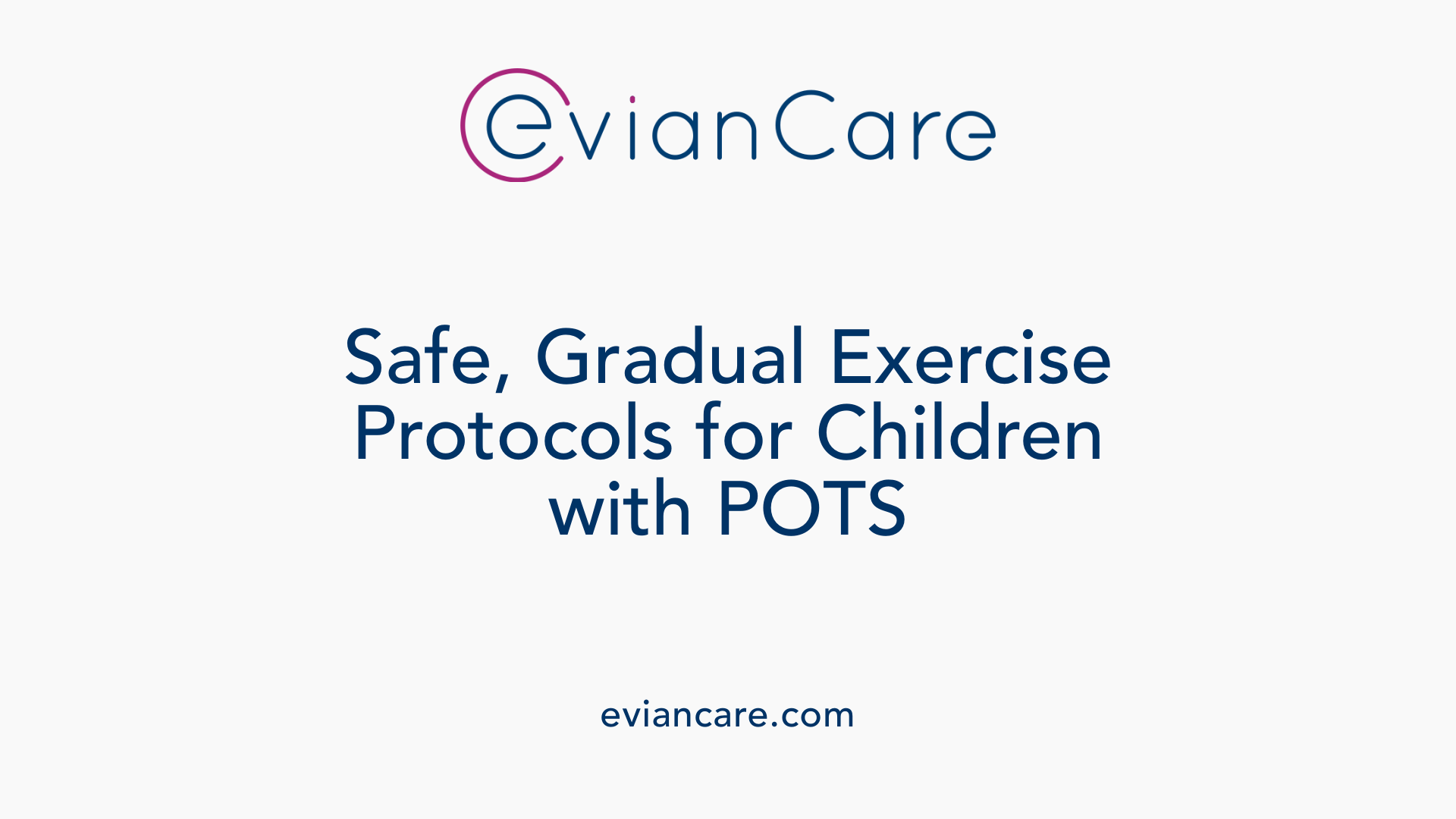
What exercise protocols are effective for children with POTS?
Pediatric patients with Postural Orthostatic Tachycardia Syndrome (POTS) benefit most from a carefully structured, graduated exercise approach. The starting point focuses on low-impact, horizontal, or reclined activities like swimming, recumbent cycling, and rowing. These modalities help minimize orthostatic stress while gradually building cardiovascular endurance.
Initially, exercises should be performed in a recumbent or seated position. For instance, using a recumbent bike or water-based activities like swimming can reduce symptoms like dizziness and fatigue. The exercises are typically scheduled 3 to 4 times weekly, emphasizing consistency and gradual adaptation.
Progression to upright activities such as upright bikes, ellipticals, and treadmill walking begins after months of adaptation, usually around Month 4-5. The pace and intensity are carefully monitored, especially through heart rate tracking, to stay within safe zones. Heart rate monitors are essential tools to prevent overexertion and adverse symptoms.
In addition to aerobic activity, strength training targets lower body and core muscles. Exercises like leg presses, bridges, and resistance-based movements are critical because they activate muscles responsible for venous return, helping reduce blood pooling and orthostatic symptoms.
Key supporting strategies include ensuring adequate hydration—often 2 to 3 liters daily—and, under medical guidance, increasing salt intake to support blood volume. Use of compression garments can also aid blood flow. Patients should be advised to rise slowly from a seated or lying position, avoiding sudden postural changes that could trigger symptoms.
Multidisciplinary support from healthcare professionals often complements these exercise routines. Occupational, physical, and psychological therapies help maintain motivation, address co-occurring symptoms like pain and fatigue, and improve overall adherence to the program.
In summary, effective protocols start with reclined or seated exercises, emphasize gradual progression, monitor physiological responses diligently, and incorporate comprehensive supportive measures to maximize safety and benefits.
| Exercise Phase | Intensity Level | Monitoring Tools | Additional Tips |
|---|---|---|---|
| Initial (Months 1-3) | Horizontal/seated | Heart rate monitors, RPE | Focus on low-impact, avoid overexertion |
| Progression (Months 4-5+) | Upright activities | Heart rate, RPE | Gradually increase duration and intensity |
| Maintenance | Mixed modalities | Heart rate, symptom check | Continue hydration, compression, paced activity |
Impact of physical therapy on symptoms and endurance
How does physical therapy help in managing symptoms and improving endurance in pediatric POTS patients?
Physical therapy is a vital component of managing Postural Orthostatic Tachycardia Syndrome (POTS) in children. Through carefully planned, individualized exercise programs, it encourages gradual improvement in cardiovascular function, exercise tolerance, and autonomic regulation.
The therapy process often begins with reclined or seated activities like recumbent biking, swimming, or using a seated stepper. These options are easier for children to tolerate initially, helping to reduce symptoms such as dizziness and fatigue while building cardiovascular endurance.
Over time, as patients gain strength and tolerance—typically around four to five months—there is a transition towards upright activities such as using an upright bike, elliptical, or treadmill. This phased progression is carefully monitored, with heart rate and perceived exertion levels guiding exercise intensity.
Incorporating strength training focused on the lower body and core is also essential. Exercises like leg presses, bridges, and body resistance routines strengthen muscles responsible for blood return. These exercises help prevent deconditioning and support orthostatic stability.
Patients participating in physical therapy sessions benefit from regular, twice-weekly exercise routines that include stretching, strengthening, and aerobic activities. These routines aim to improve functional mobility, daily activity endurance, and quality of life.
Supporting strategies like wearing compression garments and maintaining proper hydration are often integrated, further reducing orthostatic symptoms and improving circulation.
The cumulative effect of these interventions is a significant reduction in the severity and frequency of symptoms like dizziness, fatigue, and nausea, which often hamper children in their school and sports activities.
Beyond physical benefits, therapy includes behavioral strategies such as pacing, scheduling, and activity modification. These help children manage symptom flare-ups and promote long-term adherence to exercise routines.
When managed by a multidisciplinary team that includes physical therapists, psychologists, and medical providers, physical therapy not only alleviates symptoms but also restores functional independence, allowing children to engage more fully in daily life.
How does physical therapy contribute to strengthening cardiovascular response and preventing deconditioning?
A central goal of pediatric POTS treatment is to restore cardiovascular responsiveness. Structured exercise programs stimulate better blood volume regulation, increase stroke volume, and improve overall cardiac function.
Research indicates that just four weeks of targeted exercise can reverse some cardiovascular deconditioning seen in POTS. Improvements include longer load tolerances, increased peak oxygen consumption, and enhanced orthostatic stability.
Specific aerobic exercises, especially performed in recumbent positions, bolster circulating plasma volume, reduce venous pooling, and improve myocardial efficiency. These physiological adaptations help reduce the heart's tachycardic response when standing.
Prevention of deconditioning is equally critical. Schools and families are encouraged to support ongoing activity, with emphasis on gradual progression and realistic goals. Maintaining an active lifestyle prevents the decline in physical capacity that often exacerbates symptoms.
Overall, physical therapy provides a safe, monitored way to rebuild strength, endurance, and autonomic function, essential for managing pediatric POTS effectively.
Autonomic regulation and circulatory management improvement
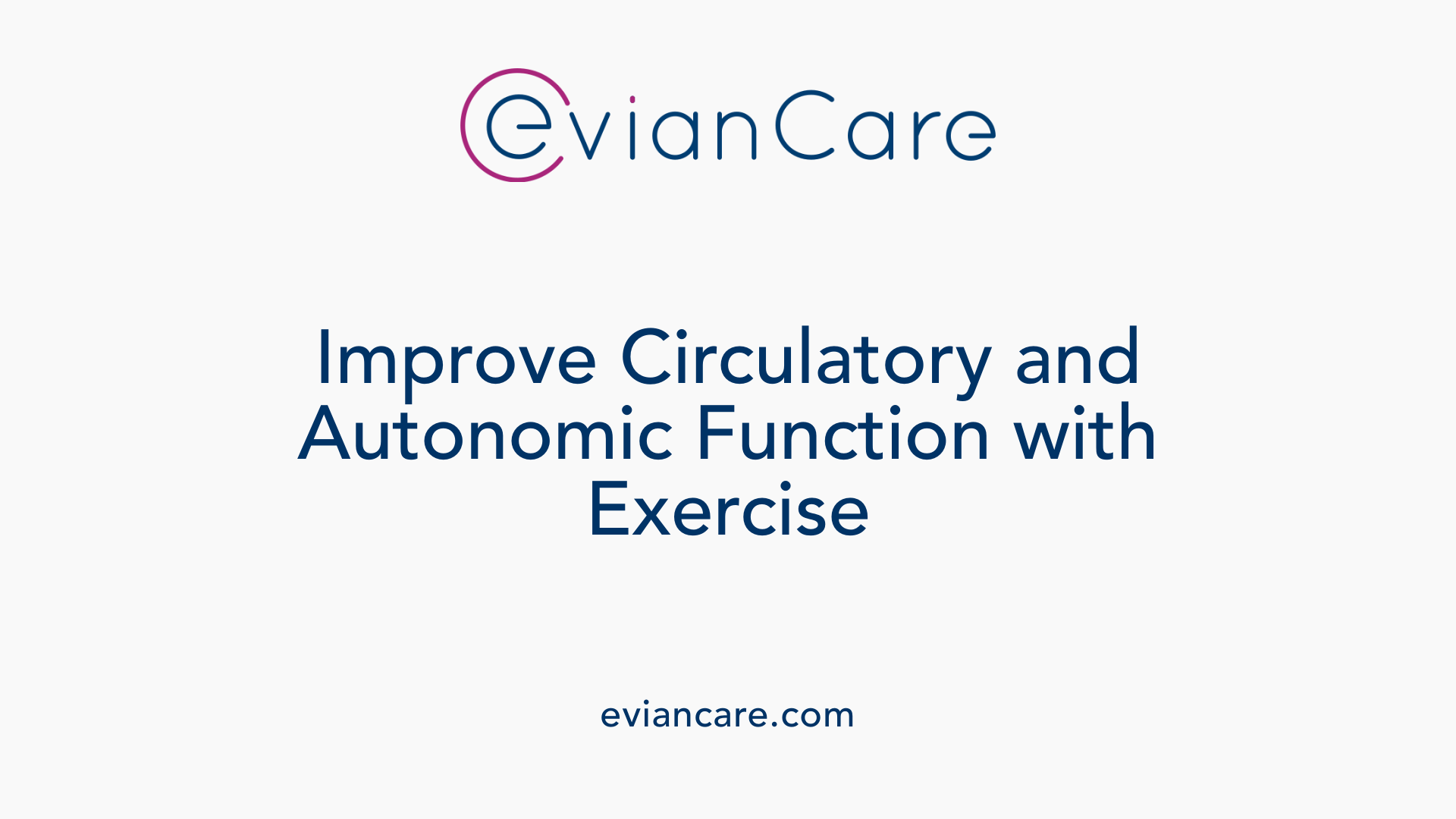
How does physical therapy contribute to better circulatory and autonomic control in children with POTS?
Physical therapy plays a crucial role in helping children with POTS improve how their bodies regulate blood flow and autonomic function. The approach involves a carefully designed, step-by-step exercise routine that is adapted to each child's ability and symptoms. Initially, children start with horizontal or seated exercises, such as recumbent biking, swimming, or seated stepper activities. These lower-impact exercises help prevent symptom flare-ups and build a foundation for endurance.
As children become more comfortable, the program gradually introduces upright activities like treadmill walking, elliptical training, and interval workouts. This gradual escalation, typically beginning around the fourth or fifth month, allows the body to adapt safely while improving orthostatic tolerance. Strengthening lower body and core muscles through resistance exercises—such as leg presses, bridges, and body resistance moves—also boosts blood return to the heart. This is vital for stabilizing blood pressure and reducing symptoms like dizziness and fatigue.
Monitoring physiological responses during exercise, especially heart rate and perceived exertion, ensures that activities stay within safe limits. This helps prevent overexertion and post-exercise malaise, common challenges in POTS management. Consistent engagement in a personalized, progressive exercise plan supports the body's ability to regulate blood flow better, enhancing overall autonomic function.
The cumulative benefit of this approach is improved circulation, increased blood volume, and enhanced autonomic responses. This, in turn, leads to decreased orthostatic symptoms, better tolerance to upright activities, and improved daily functioning. Families, clinicians, and therapists work together to maintain motivation and safety, ensuring long-term adherence and optimal outcomes.
How does this exercise-centered approach benefit pediatric POTS patients?
The structured physical therapy regimen not only addresses immediate symptoms but also promotes long-term health. It can help reverse physical deconditioning, improve cardiac and vascular health, and empower children to participate more comfortably in school, sports, and social activities. Overall, these targeted, gradual interventions create a foundation for better circulatory health and autonomic stability, significantly enhancing quality of life for young patients.
Interdisciplinary treatment models incorporating physical therapy
Are there interdisciplinary treatment options for pediatric POTS that include physical therapy?
Yes, there are comprehensive, multidisciplinary treatment options for children with POTS that incorporate physical therapy as a core component. These programs recognize that managing POTS effectively requires a team approach, combining medical, physical, psychological, and nutritional interventions.
Many specialized clinics, such as those at UCLA and the Kennedy Krieger Institute, have developed integrated care frameworks. These clinics assemble a team of healthcare providers—including pediatric cardiologists, neurologists, physical therapists, psychologists, and dietitians—to offer a coordinated treatment plan.
Physical therapy plays a pivotal role by focusing on improving cardiovascular regulation, enhancing blood flow, and increasing exercise tolerance. Since deconditioning and autonomic dysregulation are common in pediatric POTS, tailored physical therapy protocols aim to gradually rebuild endurance and stability.
The approach involves detailed assessment tools such as symptom questionnaires, orthostatic testing, and exercise testing. Based on these, clinicians develop individualized exercise routines, emphasizing gradual progression from recumbent activities to upright exercises, along with strength training.
Coordination between physical therapists and other specialists ensures that treatment plans are personalized, safe, and effective. This collaboration allows for adjustments based on symptom response, co-morbidities like autism or chronic pain, and medication side effects.
Overall, integrating physical therapy into a multidisciplinary treatment model significantly enhances the likelihood of symptom improvement, better functional outcomes, and improved quality of life for pediatric patients with POTS.
Highlights of multidisciplinary approaches to pediatric POTS
| Aspect | Description | Additional Details |
|---|---|---|
| Clinic Models | Multidisciplinary clinics at UCLA, Kennedy Krieger, Mayo Clinic | Combine medical, PT, psychological, nutritional |
| Team Composition | Cardiologists, neurologists, psychologists, dietitians, PTs | Tailored to individual patient needs |
| Treatment Focus | Autonomic regulation, exercise tolerance, symptom management | Incorporate patient-specific goals |
| Physical Therapy Role | Improve circulation, build endurance, counter deconditioning | Includes strength, aerobic, and flexibility |
| Care Coordination | Regular assessments, personalized modifications, patient education | Emphasis on safety and gradual progression |
This integrated care approach aims to address the complex, multifaceted nature of pediatric POTS. Combining expertise ensures comprehensive management, addressing immediate symptoms and fostering long-term improvements.
Supporting families and caregivers
How can parents and caregivers be educated on supportive lifestyle changes and physical therapy practices for children with POTS?
Educating families and caregivers about managing pediatric POTS involves providing detailed, easy-to-understand information tailored to each child's needs. Healthcare providers play a vital role by offering comprehensive guidance on lifestyle modifications that help reduce symptoms and improve quality of life.
One of the foundational topics is hydration and salt intake. Caregivers should be instructed on the importance of maintaining adequate fluid consumption, typically around 2-3 liters daily, depending on individual recommendations. Emphasizing the consumption of water throughout the day helps increase blood volume, which can mitigate symptoms like lightheadedness and tachycardia. Alongside fluids, increasing dietary salt—under medical supervision—can support blood pressure stabilization by promoting fluid retention.
Dietary adjustments also include eating smaller, more frequent meals. This helps prevent blood pooling and symptom flare-ups related to postprandial drops in blood pressure. Wearing compression garments, such as abdominal binders or thigh-high compression stockings, often provides additional orthostatic support by reducing blood pooling in the lower extremities.
Physical activity is a crucial component, with early emphasis on seated or reclined exercises like swimming, recumbent biking, or seated stepper workouts. Caregivers should be guided on how to initiate gradually, paying close attention to the child's tolerance. Physical therapy professionals can recommend safe activities, and caregivers should be encouraged to track symptoms and heart rate during exercise to ensure appropriate intensity.
Progression to more upright activities, like walking or treadmill use, typically starts around Month 4-5, depending on individual response. Strategies such as interval training, involving work-recovery sets tailored to the child's capacity, can enhance endurance safely. Monitoring tools like heart rate zones and perceived exertion ratings assist caregivers and children in adjusting activity levels appropriately.
Supporting mental well-being is also essential. Educators and mental health professionals can provide coping strategies, resilience training, and help integrate psychological support through counseling or peer groups. Encouraging open communication about symptoms and emotional challenges ensures the child feels supported.
Finally, integrating school accommodations, such as rest periods, flexibility with physical activities, and academic adjustments, allows children to participate fully without exacerbating symptoms. Caregivers should be empowered with information about ongoing symptom tracking, recognizing warning signs, and when to seek medical assistance.
Ongoing education, personalized care plans, and access to community support groups enable caregivers to confidently implement these strategies, ensuring a comprehensive approach to managing POTS in children.
Pharmacologic and non-pharmacologic treatments overview
What is the current scientific understanding and clinical evidence regarding physical therapy for pediatric POTS?
Recent research underscores the importance of physical therapy as a mainstay in managing pediatric POTS. Structured exercise programs tailored specifically for individual needs help improve cardiovascular health, endurance, and orthostatic tolerance.
Specialized multidisciplinary programs, like those developed at Johns Hopkins, incorporate aerobic, resistance, and stretching exercises, conducted twice weekly. These interventions focus on gradually building endurance and symptom management, guided by thorough baseline assessments such as the modified shuttle walk test that monitors heart rate and oxygen consumption.
Studies have shown that physical therapy can significantly reduce POTS symptoms, such as dizziness and rapid heart rate, by enhancing blood volume, improving cardiac function, and reversing cardiovascular deconditioning. The use of recumbent activities, such as swimming or recumbent biking, forms the foundation for initial training, with progression toward upright exercises over several months.
Moreover, innovative approaches emphasize individualized exercise plans incorporating exercise testing, symptom questionnaires, and functional assessments. Heart rate and perceived exertion levels are used to personalize exercise intensity, ensuring safety and effective progression.
These programs often include behavioral modifications, such as gradual postural changes and the use of compression garments, to optimize symptom control. Physical therapy is particularly valuable because it offers a non-pharmacological modality addressing the physiological abnormalities underlying POTS.
While the evidence supports physical therapy's effectiveness, ongoing research aims to establish optimal protocols, including the duration and intensity of exercise. As a complementary component of comprehensive treatment—including medication and lifestyle modification—physical therapy significantly enhances patients' quality of life and functional capacity.
Overall, intensified interdisciplinary efforts reinforce that exercise-based interventions are vital in pediatric POTS management, offering physiological benefits and symptom relief without the risks associated with pharmacotherapy. As scientific understanding advances, tailored physical therapy programs will likely become even more optimized for individual patient needs.
Exercise and its effects on cardiovascular and autonomic health
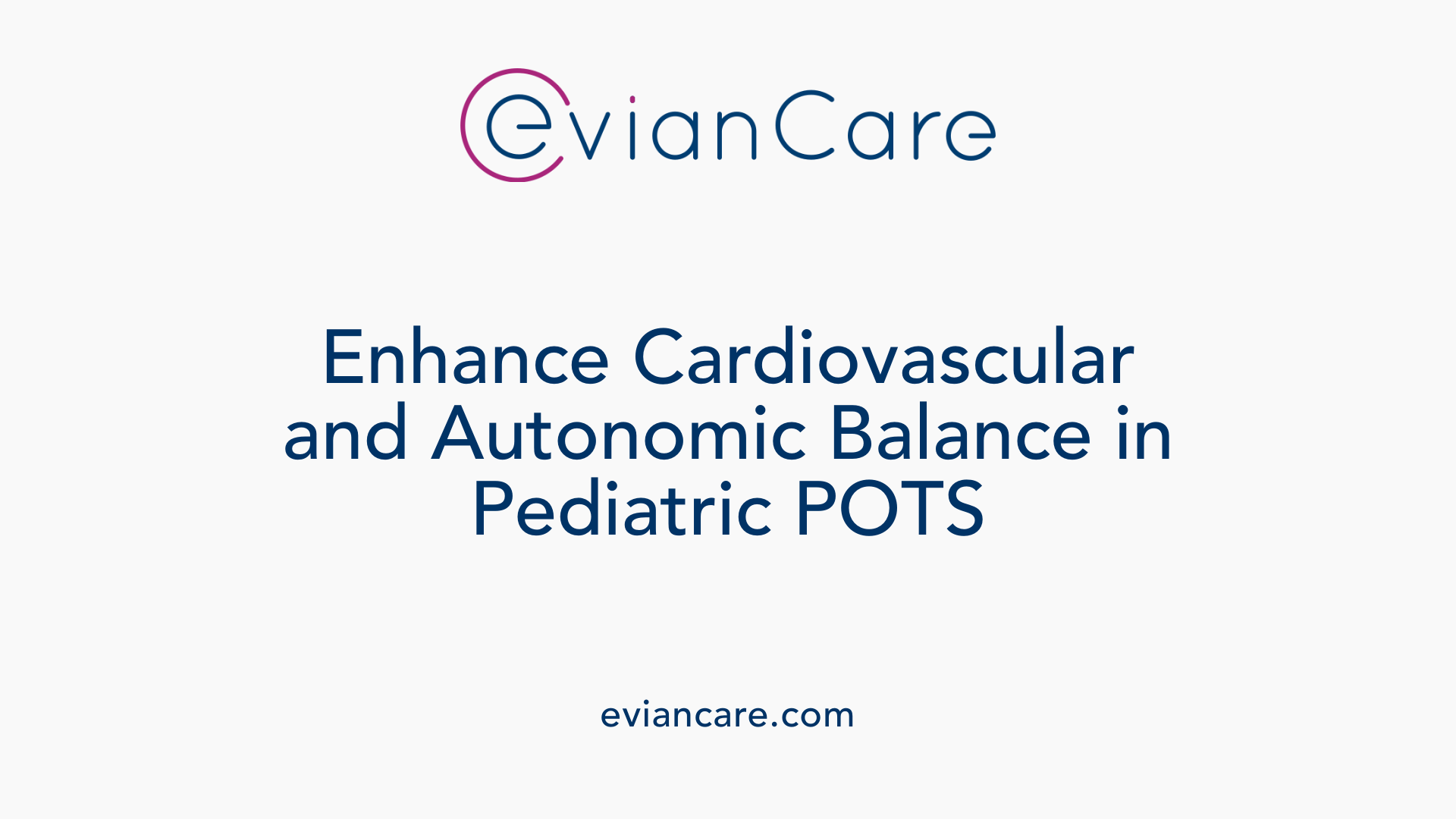
How does exercise training influence cardiovascular function and autonomic responses in pediatric POTS?
Exercise training plays a significant role in improving cardiovascular health and autonomic responses in children with Postural Orthostatic Tachycardia Syndrome (POTS). Research shows that a structured, graded exercise program can lead to measurable physiological improvements.
One notable effect is the increase in stroke volume, which is the amount of blood ejected by the heart with each beat. Studies have shown that after just four weeks of endurance exercise performed in a recumbent or supine position, children with POTS experience enhanced stroke volume, along with increased cardiac output and thoracic fluid content during orthostatic stress. These improvements mean the heart can pump more blood effectively when the child moves to an upright position.
Beyond cardiac enhancements, exercise appears to positively influence circulating blood volume. Patients often experience plasma volume expansion, which helps counteract the blood pooling commonly seen in POTS due to blood vessel dilation and venous pooling. By increasing blood volume and improving venous return, exercise reduces the severity of lightheadedness, dizziness, and rapid heart rate typically associated with orthostatic changes.
Furthermore, exercising regularly upgrades exercise tolerance. Children show longer durations on stress tests, such as cycling or treadmill protocols, and higher peak oxygen consumption (VO2). This boost in tolerance allows them to participate more fully in daily routines, including school and recreational activities.
The physiological benefits of exercise in pediatric POTS include improved myocardial function, greater blood volume, and decreased venous pooling, all of which contribute to better orthostatic endurance. This holistic enhancement supports not only symptom reduction but also overall quality of life, making exercise an essential component of comprehensive POTS management.
| Aspect of Cardiovascular Health | Pre-Exercise State | Post-Exercise Improvements | Impact on POTS Symptoms |
|---|---|---|---|
| Stroke Volume & Cardiac Output | Lower baseline during orthostatic stress | Significantly increased after 4 weeks | Improved blood flow, reduced dizziness |
| Thoracic Fluid Content | Reduced in POTS patients | Increased, indicating better blood volume | Better orthostatic stability |
| Venous Pooling | Excessive during upright posture | Markedly decreased | Less lightheadedness and tachycardia |
| Exercise Tolerance | Limited in severity | Longer load duration, higher VO2 | Enhanced daily function and activity participation |
This evidence underscores that a well-designed exercise regimen is beneficial for pediatric POTS patients, helping restore cardiovascular function and foster autonomic equilibrium. As with any intervention, personalized tailoring of activity type and intensity, along with careful monitoring, ensures safety and promotes adherence.
Customized and adaptive exercise strategies
Why is individual assessment crucial for POTS patients?
A personalized approach to exercise for pediatric POTS patients begins with comprehensive assessments. Medical professionals utilize symptom questionnaires, orthostatic testing, exercise testing, and functional evaluations to establish a baseline of each child’s capabilities and limitations. These initial assessments help determine safe starting points for exercise, identify potential triggers, and set realistic goals.
This tailored baseline ensures that exercise protocols are designed to suit each patient’s unique physiological and symptomatic profile. For example, children with higher levels of fatigue or more pronounced orthostatic intolerance may start with gentler, recumbent exercises, while others with milder symptoms can progress more quickly.
How does physiologically guided progression enhance treatment?
Progression in exercise routines for POTS should be based on real-time physiological indicators, not just prescheduled timelines. Heart rate monitoring during aerobic exercises allows clinicians and patients to stay within prescribed heart rate zones that prevent overexertion.
Rating of Perceived Exertion (RPE) offers another valuable metric. RPE scales help children and caregivers gauge exertion based on felt effort, promoting self-awareness and safer progression.
As tolerance improves, exercises can gradually become more upright, increasing cardiovascular challenge. This stepwise approach helps rebuild circulatory volume, enhance myocardial function, and improve autonomic regulation.
What is the benefit of flexibility in exercise programs?
Flexibility enables clinicians and patients to modify routines based on day-to-day symptoms, medication effects, co-morbidities, and personal preferences. An adaptable plan ensures the child remains engaged and avoids discouragement or setbacks.
By setting patient-driven progression criteria—such as achieving target heart rate zones or RPE levels—programs can be adjusted dynamically, ensuring continued safety and effectiveness.
Moreover, incorporating interval training with work-recovery sets can optimize endurance gains while minimizing symptom aggravation. This method allows children to build stamina gradually without risking post-exertional malaise.
Practical implementation of personalized exercise plans
Experts recommend combining regular assessments with flexible protocols to maintain alignment with the child's evolving condition. Use of wearable heart rate monitors, symptom diaries, and regular functional tests guides ongoing adjustments.
Such a physiology-informed, patient-centered approach fosters better adherence, reduces fears related to activity, and enhances overall quality of life for pediatric POTS patients.
| Assessment Tools | Purpose | Implementation Example |
|---|---|---|
| Symptom questionnaires | Capture subjective symptom severity and triggers | Weekly symptom scoring to guide exercise intensity |
| Orthostatic testing | Measure blood pressure and heart rate responses to change in position | Tilt table or standing tests to refine activity level |
| Exercise testing | Determine cardiovascular capacity and response | Cardiopulmonary exercise testing to set safe thresholds |
| Functional assessments | Evaluate daily activity tolerance | Walking tests or activity logs to monitor progress |
In conclusion, these assessments inform highly individualized, flexible exercise protocols that evolve with the child's recovery and adaptation, promoting safety, better adherence, and improved long-term health outcomes.
Interval training and activity modification techniques
How can interval training be incorporated into exercise protocols for children with POTS?
In children with POTS, integrating interval training into their exercise routines offers a strategic way to improve cardiovascular endurance while respecting their unique tolerance levels. This method involves alternating periods of activity with recovery phases, allowing the body to adapt gradually to increases in exertion.
Typically, short bouts of moderate-intensity exercise like brisk walking, cycling on a recumbent bike, or swimming are used. These are followed by rest or very low-intensity recovery periods. The key is to adjust the duration and intensity of each interval based on the child's response, especially considering heart rate and perceived exertion levels.
For example, a child might cycle at a moderate pace for one to two minutes, then slow down or rest for a similar amount of time. This cycle is repeated several times during the session. Over time, as tolerance improves, the duration of active intervals can be increased, or the recovery periods decreased.
Work-recovery interval sets are particularly beneficial because they simulate real-world activities and promote cardiovascular resilience. They also help avoid post-exercise symptoms such as dizziness or fatigue, which are common in POTS patients.
Monitoring during these sessions involves tracking heart rate within prescribed zones and using RPE (Rating of Perceived Exertion). Adjustments are made based on ongoing assessment, ensuring activity remains within safe limits.
Incorporating interval training requires a personalized approach. Each child's exercise program should begin with a thorough assessment, including baseline orthostatic testing and symptom evaluation. Regular re-evaluation helps tailor the intensity and duration of intervals to promote safe, sustainable improvement.
Overall, interval training, combined with individualized monitoring and gradual progression, enhances endurance outcomes while reducing the risk of overexertion, making it a cornerstone of effective exercise therapy for children with POTS.
Long-term maintenance and adherence strategies
How can pediatric POTS patients maintain exercise adherence over the long term?
Maintaining consistent exercise habits is crucial for managing POTS symptoms effectively in children and adolescents. The foundation of long-term adherence lies in creating a safe, manageable, and engaging exercise routine that fits seamlessly into daily life.
Structured schedules help introduce routine and predictability, reducing the likelihood of skipping sessions. Setting clear, achievable goals provides motivation and a sense of accomplishment. Positive reinforcement, such as praise and rewards, encourages children to stick with their program.
Involving children in selecting activities they enjoy—like swimming, walking, or yoga—can make exercise more appealing and less of a chore. Tailoring activities to individual preferences ensures higher engagement and sustained effort.
Education plays a pivotal role. Teaching patients and their families to recognize symptoms and adjust exercise intensity accordingly supports safety and builds confidence. This knowledge helps prevent overexertion, which can lead to setbacks.
Family involvement enhances accountability and offers emotional support. Encouraging parents or caregivers to participate strengthens motivation and helps maintain routines.
Regular follow-up visits with healthcare providers allow for progress tracking, addressing concerns, and making necessary adjustments. These touchpoints reinforce commitment and help troubleshoot barriers.
Emphasizing the tangible benefits of exercise—like reduced dizziness, increased energy, and improved quality of life—drives ongoing participation. When children experience positive changes, they are more likely to perceive exercise as a beneficial and sustainable part of their health management.
Overall, fostering a supportive environment that combines safety, personalization, education, and motivation encourages long-term adherence to exercise routines for pediatric POTS patients.
| Strategy | Details | Additional Info |
|---|---|---|
| Safety and consistency | Structured schedules, symptom management, and safe activities | Personalize with medical guidance to avoid overexertion |
| Motivational techniques | Goal setting, positive reinforcement, and enjoyable activities | Aligns with child's interests and developmental level |
| Exercise as daily routine | Incorporate into everyday life, family involvement, regular follow-up | Helps make exercise a habitual and enjoyable part of life |
By implementing these approaches, pediatric POTS management becomes more sustainable, reducing obstacles like fatigue, fear, and lack of motivation, ultimately leading to better health outcomes.
Addressing co-morbidities and pain management
How does physical therapy integrate with managing co-occurring pain in pediatric POTS?
Many children with POTS also experience chronic pain, including headaches, migraines, abdominal pain, and musculoskeletal discomfort. Addressing these pain issues is crucial for improving overall quality of life and functional capacity.
Physical therapy plays an integral role in managing co-occurring pain through a multimodal and personalized approach. Initially, gentle, reclined exercises such as stretching, low-intensity resistance work, and relaxation techniques help reduce pain episodes and promote tolerance to activity.
Targeted strengthening exercises focus on the musculoskeletal system, especially muscles supporting blood circulation, such as the legs and core. These help alleviate musculoskeletal discomfort and improve posture, which can lessen pain triggers.
Stretching routines, combined with breathing and relaxation strategies, aim to ease tension and reduce episodic pain. These are often incorporated alongside pacing and activity management to prevent overexertion.
Psychosocial support, including cognitive-behavioral therapy (CBT), is often integrated into the treatment framework. CBT helps address pain perception, emotional resilience, and coping strategies, which are crucial given the overlap of physical and psychological stressors.
A multidisciplinary team, involving physiotherapists, psychologists, and medical providers, ensures that therapy plans are tailored to each child's specific symptom profile and needs.
Studies underscore the importance of comprehensive management. For example, combining physical therapy with behavioral support and medication can result in better pain control, increased activity levels, and improved overall well-being.
In summary, physical therapy within a broader, multidisciplinary context offers a promising avenue to reduce chronic pain, enhance functional mobility, and support psychological health in pediatric POTS patients.
Scientific evidence supporting physical therapy in pediatric POTS
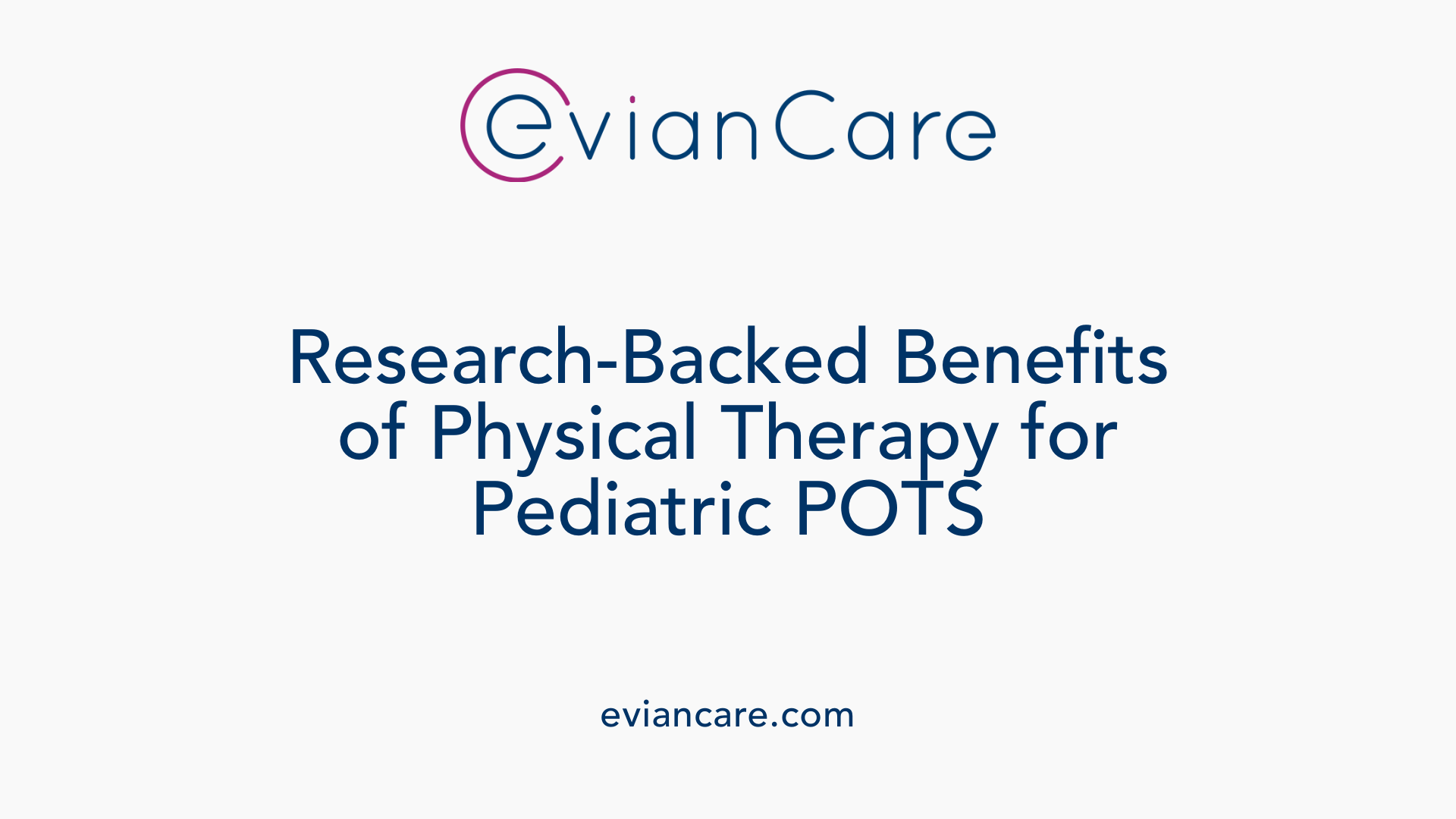
What is the current scientific understanding and clinical evidence regarding physical therapy for pediatric POTS?
Recent research highlights that physical therapy plays an essential role in managing pediatric Postural Orthostatic Tachycardia Syndrome (POTS). Structured exercise programs, especially when tailored to the individual, have been shown to bring about noteworthy physiological and functional improvements.
In particular, interdisciplinary care approaches, such as the comprehensive programs developed at Johns Hopkins, emphasize graded aerobic and resistance exercise. These programs typically begin with horizontal or recumbent exercises like swimming, recumbent biking, or rowing, which aim to improve circulation and cardiovascular strength without exacerbating symptoms.
As patients adapt, the programs often incorporate upright activities around the 4th or 5th month, carefully monitored with heart rate and perceived exertion levels to ensure safety. These strategies help gradually rebuild orthostatic tolerance—a patient's ability to stand upright without symptoms such as dizziness or rapid heartbeat.
The improvements from physical therapy are measurable. Patients often experience a decline in heart rate increases during standing tests, enhancements in blood volume, and better overall endurance. Functional gains include better participation in daily activities, school attendance, and sports. Moreover, patients report improvements in symptom severity, including reduced dizziness, fatigue, and nausea.
Multiple studies indicate that exercise can positively influence cardiovascular deconditioning, a common feature in POTS patients. For example, four weeks of recumbent endurance exercise increased stroke volume, cardiac output, and thoracic fluid content during orthostatic stress tests. Longer-term programs support sustained benefits in vascular tone and orthostatic stability.
While medications such as ivabradine, midodrine, and volume expansion are utilized, their combination with physical therapy often results in superior outcomes. Exercise alone can significantly enhance autonomic regulation, even in the absence of pharmacological agents.
Despite these promising findings, definitive large-scale clinical trials specific to pediatric populations are limited. Most evidence comes from multidisciplinary programs and smaller studies that demonstrate safety and efficacy in improving both physiological responses and quality of life.
Overall, current understanding underscores the importance of individualized, progressive physical therapy as a core pillar in the holistic management of pediatric POTS. It is recognized as a safe, effective, and non-invasive approach to improving symptoms, enhancing functional capacity, and supporting the child's overall well-being.
Innovative approaches and future directions
How are new techniques shaping exercise therapy for POTS?
Recent advancements are emphasizing more personalized and adaptive exercise routines for POTS patients. Traditional protocols often face adherence issues due to their rigidity and one-size-fits-all nature. Modern approaches are incorporating assessments like symptom questionnaires, orthostatic testing, and functional capacity evaluations to tailor exercise plans specifically to each individual's needs.
Interval training, which includes alternating work and recovery periods, has gained popularity. This method allows for gradual improvement of endurance and autonomic function, with adjustments made based on real-time physiological responses. For instance, work-recovery sets can be adapted dynamically using heart rate and perceived exertion metrics to enhance safety and efficacy.
How is technology being integrated into POTS rehabilitation?
Technology plays a crucial role in monitoring and guiding exercise therapy for POTS. Wearable devices now enable continuous tracking of heart rate, oxygen saturation, and activity levels. These tools help ensure patients stay within prescribed heart rate zones and provide immediate feedback on exertion levels.
Mobile health applications and remote monitoring platforms are also increasingly used, allowing healthcare providers to supervise progress and modify programs without requiring frequent in-clinic visits. Telehealth consultations ensure ongoing support and adjustments based on patient-reported outcomes and device data.
Furthermore, advanced exercise machines equipped with biofeedback systems assist patients in maintaining optimal postures and effort levels, reducing the risk of symptom exacerbation. AI-driven algorithms analyze this data to fine-tune exercise prescriptions in real time.
What role does personalized medicine play in future POTS management?
Personalized medicine is at the forefront of evolving POTS treatment strategies. By integrating genetic, physiological, and psychosocial data, clinicians can develop highly individualized exercise and medication plans. Biomarkers such as plasma copeptin levels and responses to initial testing help predict treatment success and guide medication choices like ivabradine or metoprolol.
Incorporating psychometric tools enables addressing comorbid conditions like chronic pain, anxiety, or depression, which frequently co-occur with POTS. This holistic approach ensures that exercise programs are safe, effective, and aligned with each patient's unique profile.
Advanced diagnostic tools, including detailed cardiopulmonary exercise testing and autonomic function assessments, inform tailored progression strategies. For example, setting specific heart rate and exertion targets based on individual baseline data helps optimize aerobic and resistance training.
How do these innovations combine to shape the future of pediatric POTS management?
The synergy of new techniques, technology integration, and personalized medicine promises to transform POTS management, especially in pediatric populations. Programs will likely become more dynamic, adaptive, and engaging, leading to better adherence and outcomes.
Educational and behavioral strategies supported by digital platforms will enhance patient motivation and confidence. Moreover, continuous feedback and data collection will allow for early identification of flares or setbacks, enabling prompt intervention.
By moving towards a more precise, data-driven approach, future therapies will better address the variability inherent in POTS, ensuring that each child receives the most effective and safest treatment tailored to their unique needs.
| Aspect | Current Practice | Future Directions | Supporting Technologies |
|---|---|---|---|
| Exercise Protocols | Fixed schedules, limited individualization | Adaptive, personalized routines with real-time adjustments | Wearable devices, biofeedback systems, AI algorithms |
| Monitoring | Sporadic, clinic-based | Continuous, remote tracking | Mobile apps, remote sensors |
| Treatment Planning | General guidelines | Data-driven, biomarker-informed | Genetic testing, autonomic function tests |
| Patient Engagement | Limited feedback | Interactive and responsive platforms | Telehealth, gamification tools |
These innovations aim to make rehabilitation in pediatric POTS more effective, accessible, and patient-centered, ultimately improving quality of life and functional outcomes for affected children.
Conclusion and clinical implications
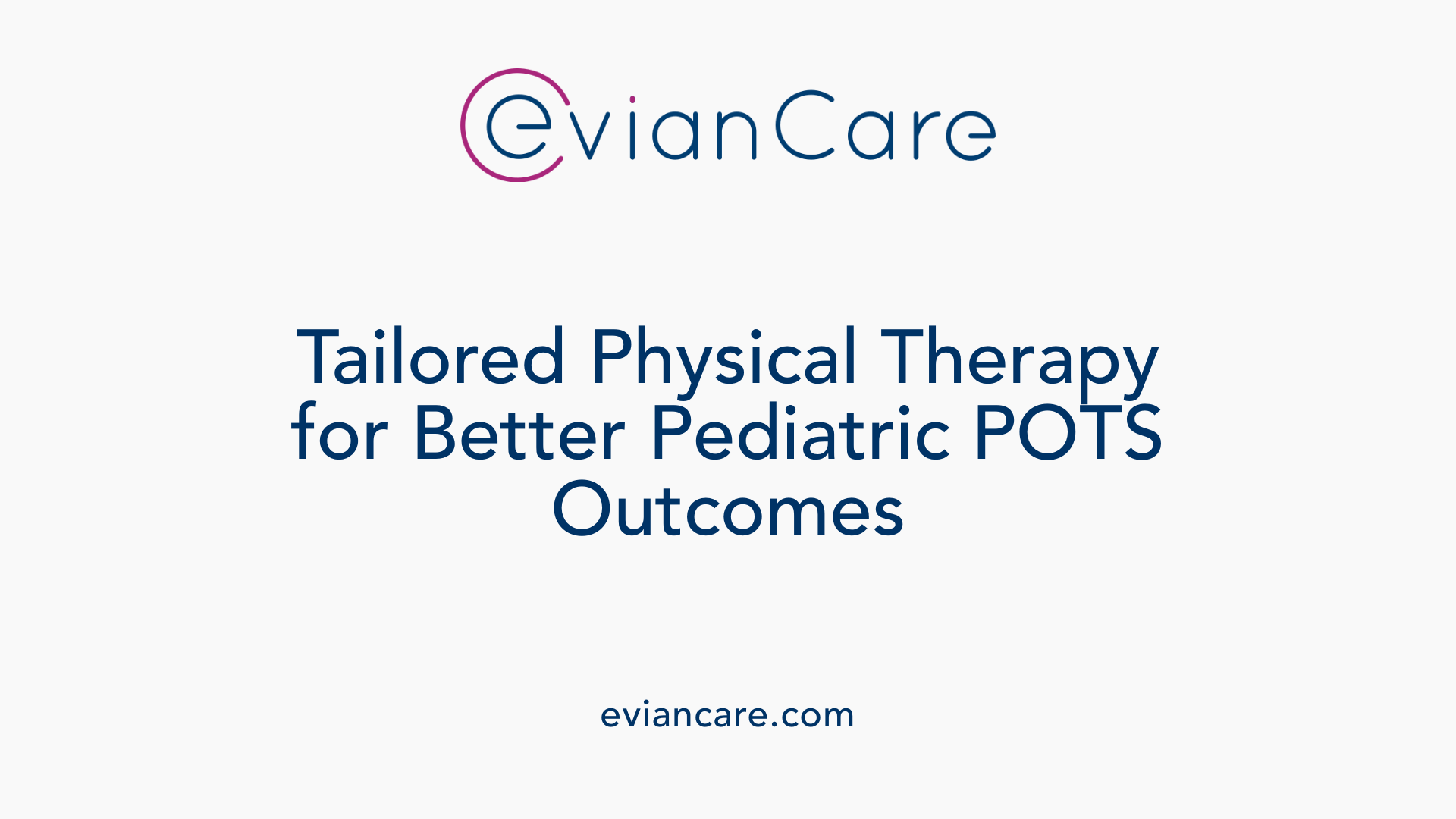
How does physical therapy benefit children with POTS?
Structured exercise training stands out as a core element in managing pediatric POTS. Evidence shows that tailored programs focusing on both aerobic and strength exercises can significantly improve cardiovascular health. For example, recumbent activities like swimming and cycling help build blood volume and circulation without overwhelming orthostatic systems initially. As children adapt, they may gradually progress to upright exercises, which enhance their ability to tolerate daily activities.
By carefully monitoring heart rate and perceived exertion, clinicians can customize these programs, ensuring safety and effectiveness. Improvements observed include reduced heart rate spikes during standing, increased orthostatic tolerance, and enhanced endurance. These physical gains often translate into better functioning at school and during sports.
Why should programs be personalized?
Adherence to exercise routines can be challenging due to factors like post-exertional malaise, fear of symptoms worsening, or co-existing conditions such as pain. Rigid, one-size-fits-all protocols may limit participation and benefit.
A tailored program considers individual symptoms, baseline fitness, and response to activity. It involves initial assessments—such as functional tests and symptom questionnaires—to set realistic goals. Progression is then guided by specific metrics including heart rate zones and patient-reported exertion levels.
Using an individualized approach increases motivation, reduces dropout rates, and enhances safety. Incorporating tools like interval training and patient-driven progression helps optimize improvements while respecting each child's unique response.
What is the role of multidisciplinary care?
Managing pediatric POTS effectively often requires a team of healthcare professionals. Physical therapists work alongside occupational therapists, psychologists, and physicians to address not just physical symptoms but also emotional and social challenges.
Behavioral strategies, such as scheduling modifications, mental health support, and education, complement physical training. For children experiencing associated chronic pain, multidisciplinary programs at institutions like Mayo Clinic and Cleveland Clinic are especially beneficial.
This comprehensive care approach ensures that exercise therapy is integrated into broader lifestyle and medical management. It enhances overall quality of life, fosters resilience, and supports sustained long-term improvements.
| Aspect | Details | Additional Considerations |
|---|---|---|
| Exercise Focus | Recumbent activities initially, progression to upright | Individual tolerance guides progression |
| Monitoring | Heart rate, RPE, symptom scores | Adjust intensity based on feedback |
| Multidisciplinary Role | Collaboration among therapists, psychologists, doctors | Addresses physical, emotional, behavioral needs |
| Expected Benefits | Improved orthostatic tolerance, increased volume, better endurance | Reduced symptoms such as dizziness and fatigue |
| Challenges | Adherence issues, variability in response | Personalization and motivational support are crucial |
How does this approach align with current scientific understanding?
Research underscores that graded, individualized exercise programs are beneficial for pediatric POTS. Studies demonstrate improvements in heart rate regulation, blood volume, and functional capacity. These programs are most effective when implemented as part of an interdisciplinary plan, combining physical activity, behavioral interventions, and medication management where necessary.
Despite the lack of FDA-approved drugs specifically for pediatric POTS, ongoing research into pharmacological agents like ivabradine and midodrine supports their adjunctive use. Still, non-pharmacologic strategies like tailored exercise remain foundational.
In conclusion, adopting personalized, multidisciplinary exercise protocols based on current evidence can significantly enhance outcomes for children with POTS, helping them regain independence and improve their quality of life.
Transforming Pediatric POTS Care with Personalized Physical Therapy
As emerging research continues to validate the efficacy of tailored exercise interventions, physical therapy stands at the forefront of nonpharmacologic management for pediatric POTS. Through patient-specific assessments, progressive training, and multidisciplinary collaboration, clinicians can enhance orthostatic tolerance, reduce symptoms, and improve overall quality of life. Emphasizing safety, adherence, and family engagement is essential for long-term success. Future innovations, including technology integration and personalized medicine, promise to further refine these strategies, offering hope for improved outcomes and greater functional independence among children living with POTS.
References
- Instructions for POTS Exercise Program—Children's ...
- PT for POTS
- Lifestyle Changes to Make When Your Child Has POTS
- Pain Management In Pediatric Patients With Postural ...
- Management of Postural Orthostatic Tachycardia ...
- Exercise training improves circulatory dynamics in ...
- Adaptive Approaches to Exercise Rehabilitation for ...
- PT for POTS
- Pain Management In Pediatric Patients With Postural ...












